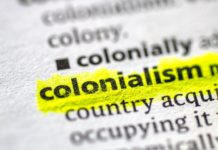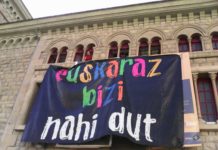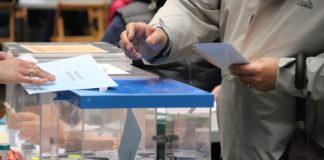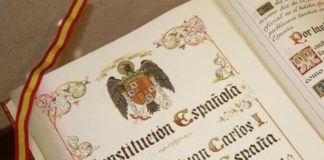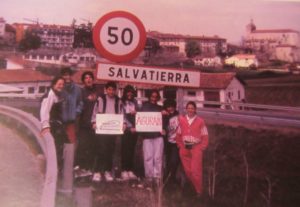
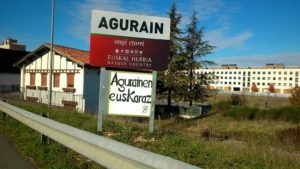
Dark in the past, dream in the present, you bet it is reality tomorrow.
Geographic and historic location of Agurain.
Agurain is a town located in the eastern Álava Plains (Arabako Lautada). Presently, it is home to approximately 5,000 inhabitants, with the rate of Basque speakers rising to 30%, especially young people.
The process towards Castilian-Spanish started in 1256. The king of Castile Alfonso X stripped Hagurahin of its name—form attested for the first time in a 11th century document of the San Millan de la Cogolla monastery—and named it Salvatierra instead. After that a number of records testify to the link between Agurain (Salvatierra) and Basque, the last one going back to 1842. A judiciary statement records the need for an interpreter, a job assigned to a man called Ignacio Aristimuño. When it comes to place-names, Agurain and its geographic milieu bear witness to ubiquitous Basque names (see Euskararen bidea Agurainen, Aguraingo Euskalgintza eta Itziar Amestoy, Arabako Foru Aldundia, Vitoria-Gasteiz, 2010).
Adults’ Basque language learning
The process for revitalization of Basque kicked off underground in 1967, during Franco’s dictatorship. Basque teaching set out in ‘evening’ lessons, attended by adults as pupils. The lessons transmitted Basque culture along with Basque language, including the teaching of Basque three-hole flute or txistu, dances, music, hill-walking outings, festivals, etc. An initiative called “Baietz euskara” was also launched [approx. “Basque language challenge”] to create a space aimed at listening and using Basque that led to the establishment of an association. It contributed to Basque awareness and Basque culture transmission.
From Spanish language schools to Basque schools
The academic year 1973-1974 saw the launch of the Basque school or ikastola Lopez de Larrea at a room in the priest house. A group of parents, organized in a cooperative, and Basque language activists promoted the project. Up to that point, there were no options but either a religious school or the state-run schools, all of them in Spanish. Agurain held a population ranging from 3,000 to 3,500, many of them labour originating from Spain, and the town’s inhabitants were overall Spanish speakers. Presently, a public ikastola exists, Lopez de Larrea, as well as the Lautada Ikastola, sustained by community support, in the one-time religious school. Agurain offers also a secondary school, Aniturri Institutua, and a vocational training establishment, with Basque as instruction language, called D model (D eredua).
“Agurain 75 hours in Basque” initiative
This initiative developed on 8, 9, 10 and 11 November 2016. However, its preparation made up for the most important moment. Basque language activists engaged in a preparation of six months ahead of the initiative. The warm-up entailed talking to people in the street, both individuals and professionals; interacting with cultural and community agents from all kinds from associations, educative institutions, organizations, societies, and retail; providing explanations to everyone on the ins and outs of the initiative; finally, requesting their involvement. Following the first stage, a list was drawn up sorting participants according to their linguistic competence, designing thereafter a town’s linguistic map and identifying willing shops with stickers on their access doors. In addition, publicity was distributed and a series of events were held, such as presentations, dancing sessions, bar hopping evenings, poster design workshops followed by distribution, Internet information elaboration and diffusion, etc. The campaign put a special emphasis on asking Basque speakers to use it whenever they could, and use mild, engaging, pleasant manners, especially not upsetting if someone showed a hostile stance. Nowadays, 800 people over 18 can speak Basque. 284 people committed to engage in Basque speaking, with 134 associations and entities preparing to welcome incoming Basque speakers.
Concerns ahead of the campaign
We need to make one thing clear first of all—the initiative “Agurain 75 hours in Basque” takes place in a town where Basque had almost vanished, a town devoted to bringing back to life its secular language. Therefore, this program could be helpful to many towns with a similar sociolinguistic situation, while a town showing a rate of, say, 60% of Basque speakers, may need to significantly adapt this initiative to cater for their needs in order to be effective.
The campaign “Agurain 75 hours in Basque” took off after ascertaining that we, Basque speakers, often fail to introduce ourselves as speakers of that language, quickly switching to Spanish with no other reason. We Basque speakers interact in Spanish, since we are used to it since we got to know each other, and do not make the most of the language competence held in Agurain. In fact, 55% of its residents understand Basque, but Spanish speakers request right away to switch to Spanish, without minimally attempting to understand their conversation partners.
Behaviour expected from Basque speakers
The following advice has been given:
- First of all, regardless of the situation, introduce yourself as a Basque speaker by uttering your first word in Basque
- Interact with everyone in Basque until you are requested otherwise
- Speak in Basque if the conversation partner is a Basque speaker (one should show clearly their linguistic preferences)
- If the conversation partners understand Basque, engage in a bilingual conversation, with one in Basque and the other in Spanish / other
- Get a compromise from non-Basque speakers around to make some advance, no matter if they switch to the other language later
- Faced with a hostile response, calibrate the situation, avoid dispute, and respond with smile and assertiveness.
Behaviour expected from Spanish speakers
Non-Basque speakers are requested to be flexible and show sensitivity towards speakers engaging in Basque, that is all they are asked to do. Advice to non-Basque speakers is set down in nine languages: Basque, Spanish, English, German, French, Galician, Catalan, Hassaniya from Sahara, and Arabic. All of them can be found on the Internet: https://aguraineneuskaraz.wordpress.com/erdaldunentzako-gomendioak/
Getting Agurain ready
A number of activities took place in order to get an optimist atmosphere, such as the organization of workshops to learn techniques allowing for an easy and comfortable use of Basque in all settings; publication of a guide containing recommendations to live in Basque; quest, conversation and persuasion of people and groups eligible to join the initiative; posting of identification stickers on shops; request for cooperation and flexibility to non-Basque speakers, at least for a 75 hour span.
After-initiative assessment of “Agurain 75 hours in Basque”
On completion of the campaign, a questionnaire distributed among participants delivered a very positive response:
- This project has spurred changes in linguistic habits.
- On specific settings arranged to facilitate use, new relationships have come up around the Basque language.
- A segment of participants, 79%, introduced themselves as Basque speakers, uttering their first word in Basque.
- 60 people have made Basque compelling in their environment.
- It has been an activation based on reality. There is still a long path to go from basic activation to feel Basque as a compelling.
- The insufficient competence of Basque showed by conversation partners limits interactions.
- Non-Basque speakers have an entrenched habit to switch to their native language; Basque speakers have felt constraint, social pressure.
- The privileges of Spanish speakers are too conspicuous on face-to-face interaction, generating difficulty to go beyond primary active behaviour.
Further information available in https://aguraineneuskaraz.wordpress.com/

